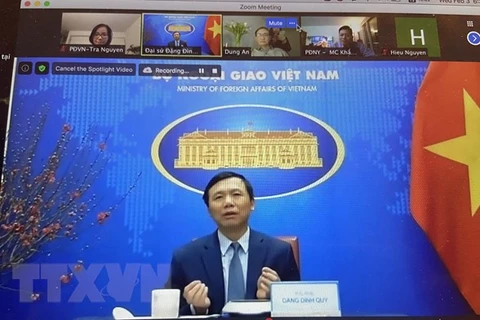Hanoi (VNA) - According to the Nguyen feudal dynasty’s etiquette, the “Thuong tieu” (neu pole erection) ceremony should be organised on the 23rd day of the 12th month of the lunar year, heralding the passing of the old year and the approach of the Tet festival.
Neu is a long and beautiful bamboo with a circle hung on its top, believed to be able to ward off evils so that the souls of the ancestors can enjoy Tet, the most important festival in the Vietnamese calendar, together with their living family members.
On January 25, the 23rd day of the 12th month of the lunar year, the Hue Ancient Capital Relic Conservation Centre holds a ceremony in the Hue Royal Citadel.
The neu pole erection for the Lunar New Year is a traditional practice of the Vietnamese, and also an important etiquette to welcome the new year of the Nguyen dynasty court.
Households could only erect neu poles after the one at the shrine worshipping the founding king of the Nguyen dynasty had been completed.
Under the Nguyen dynasty’s traditional etiquette, the poles are erected in front of palaces, pagodas, Thai Hoa Palace and shrines in the inner capital.
The one erected in the inner capital is a long, big and strong bamboo pole measuring about 15 metres, with leaves left on its top, often with a line of beautiful words for good luck in the coming year.
Under the reign of King Minh Mang, the royal court often selected several seals to be hung on top of the pole, implying that the court will not receive official documents or use the seals so that it can take the work off for the festival. The seals bear the image of a dragon, symbolising the power of the king.
In strict observation of the traditional practice, the centre selected several seals, placed them in a basket and hung them on the pole.
Dressed as mandarins and soldiers of the Nguyen dynasty and escorted by royal music and flag troupes, those performing the neu procession start their work from Hien Nhon Gate. To ancient music, 10 soldiers carry the pole and march to the Royal Palace, through the shrine worshipping the founding king of the dynasty and the Thai Hoa Palace to the main gate of the shrine, worshipping the kings before starting the erection of the pole.
At the shrine where the kings are worshipped, offerings such as pork, chicken, sticky rice and fruits are made on an altar. In the old days, the offerings were prepared by the royal Ministry of Culture. To the music of the royal troupe, the 10 soldiers start to erect the pole.
Under ancient rule, residential households could start the work only after they had seen the pole in the royal palace. On the 7th day of the 1st month of the lunar year, the poles would be lowered, marking the end of the Tet festival when the court started to resume the use of the seals, farmers restarted their work in the fields, and life went back to normal.
Neu pole erection is a traditional etiquette announcing the approach of the Tet that invites ancestors back to their families to enjoy the important festival with their descendants, nurturing the dream of a new year full of successes and happiness. This helps explain why the practice has been kept and passed down from one generation to another for millennia.
This year, as the COVID-19 pandemic was developing in a complicated way, the centre held a ceremony at the shrine worshipping the founding king and worshipping the kings only. The number of visitors witnessing the ceremony was also much smaller than that of other years. All of the participants observed the 5K rules to keep themselves from contracting the virus./.

























